Like Quake and SimCity, Diablo is a game that has evolved over many years to become an unquestionable classic. The first version for the Mac was released in 1998, and though a good eighteen months behind the PC version, its release coincided with the launch of the original Bondi blue iMac, on which it played very well (AppleLust editor Marc Messer reviewed this game back in 1998 for AppleWizards, see here). The action took place in the town of Tristram, or more correctly in the caves and catacombs underneath the Tristram, where the player was pitted against the monsters, demons and corrupted undead warriors. Though a great single player game, it was even better as a multiplayer game, either on a local network or across the Internet, and before too long thousands of people joined forces to work together and trade magical items. An expansion pack to that first game called Hellfire (that sadly never made it to the Mac) stretched the adventure a little further into the surrounding countryside, but it was the sequel, Diablo 2, released in 2000, that really let the player explore much more of the world in which the action takes place. Instead of just a single set of caves, the game spanned four different environments including deserts and jungles, as well as numerous smaller caves and buildings. Even the town of Tristram was revisited, albeit as a scene of desolation. An expansion pack, called Lord of Destruction, came out a year later simultaneously for both the PC and the Mac stretched the game further, adding two new character classes and a huge new landscape of mountains and icy caves to explore, as well as some very tough new monsters.
All the Diablo games feature rich graphics, detailed manuals covering both gameplay and the history of the action takes place in, and truly superb music by Mark Uelmen that covers a wide sweep of moods and ethnic sources. For those that don’t have the game, Blizzard have posted MP3 versions of the soundtrack here, and elsewhere on the website there are all sorts of extras to draw you into the world of Diablo.
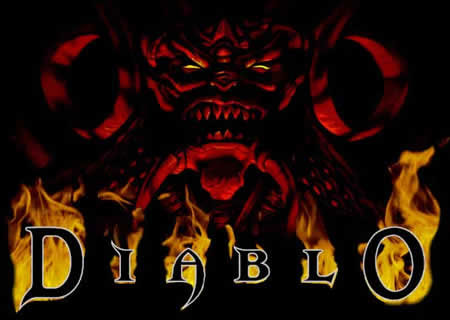
Role playing or Hack-and-Slash?
Essentially, Diablo is a sword-and-sorcery action game in which the player combats the forces of evil using various combat and magical abilities, depending on the character class he or she chooses to use. Druids, for example, can call upon the forces of nature and have wolves and bears fight alongside them, while rogues use their skill with the bow to shoot down enemies from afar. With each new skill level earned, the player gets points to improve existing skills or add new ones, and since each character class has lots of possible skills, the player has plenty of scope for customizing their characters. But at the same time as the player progresses through the games, the monsters get ever more numerous and difficult to beat, and if you spread your character development points across too many skills, then none of them will be strong enough to help you defeat the toughest monsters in the game. To be successful then, the player must plan ahead, concentrating on certain sets of skills to specialize their character in a certain way.
Equipping the character is important too, and in multiplayer games a thriving market for unwanted items allows players to get the right tools for the job. Each time a monster is killed or a treasure chest opened there’s a chance of finding some magical weapons or armour. The value of these items can vary from the mundane to the exceptional, with many players looking out for “sets†of items that have enhanced magical abilities when used together. Though much of the paraphernalia of the game are solidly set in a mythical European Middle Ages, there are crossovers from different cultures and times, such as Roman gladius, Arab shamshir and Japanese katana swords. Weapons and armour have subtle effects beyond mere killing power and protection. Heavy armour slows a character down and reduces the distance a character can run before running out of breath, and some weapons will reach further but move slower than others, making combat with a two-handed Dacian falx rather different to fighting with spiked club and shield. Most interesting of all are the jewels, gems and rune stones found in Diablo 2. By plugging these into the sockets found on certain items, magical properties can be added to them. Certain combinations create unique “crafted items†with extra abilities, if the right recipe is followed.
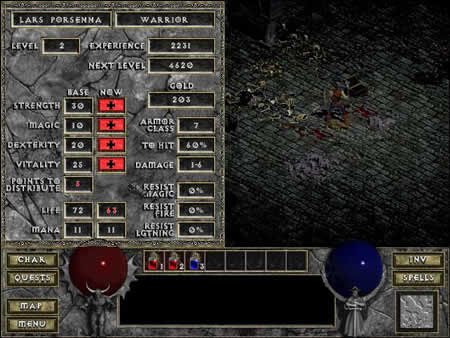 |
|
Distributing skill points sensibly is essential if your character is going is going to have any chance of doing well in the later stages of the game, be it the original Diablo as here or the sequel.
|
Does this make Diablo a role playing game like Baldur’s Gate? Not really, ultimately the game runs along pretty well preset lines, and though the characters can be tweaked in a limitless number of ways they don’t have any sort of depth to them. They don’t have reputations to worry about or moral alignments. In the multiplayer game, some players use their characters to kill other players and steal their stuff, and perhaps these come closest to being “evil†characters, but essentially the game keeps the player on the side of good and opposed to Diablo and his hellish allies.
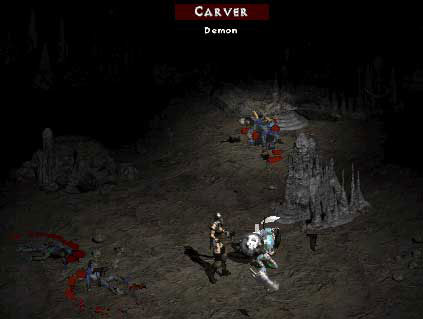 |
|
The assassin is one of the character classes that came with the Diablo 2 expansion pack. If you ever wanted to see play at being Buffy the Vampire Slayer, here’s your chance.
|
Diablo: A Manichaean Myth for the Modern Age?
The Diablo games take place in the world of Sanctuary, where various human communities have found themselves caught up in a struggle between the forces of good and evil, led by angels on one side and demons on the other. By themselves the forces of good cannot defeat evil, indeed, it seems that evil is well on the way to winning, and that is where the hero comes into the game. In the original game the player wins by defeating Diablo, and taking aboard his evil spirit by sticking a “soul-stone†into his head. Strange but true. Anyway, the spirit of Diablo takes control of the hero, and as the Dark Wanderer he sets out to free his trapped brothers, Mephisto and Baal, from their imprisonment elsewhere in Sanctuary. This is where Diablo 2 begins, with a new hero on a new quest, this time to defeat Diablo forever. Along the way the forces of good are represented by occasional meetings with the angel Tyrael and more consistently with the sage Deckard Cain and various hirelings that willingly fight alongside you.
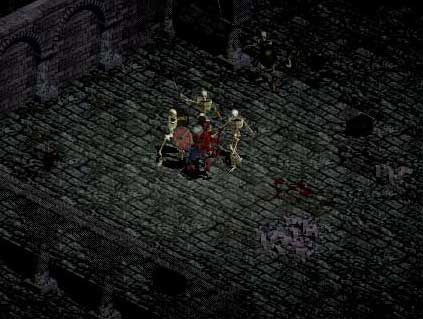 |
|
These skeletons are the least of the problems this fighter will have to deal with to complete the original Diablo game.
|
Though the appearance of angels gives the game a vaguely Judaeo-Christian feeling, really the game occupies a very different theological world. Essentially Diablo takes place within a dualistic cosmology, where equal and opposite forces of good and evil are in conflict, sweeping through the material world influences the actions of mortals one way or the other. This is the similar to the mythology promulgated by the Persian philosopher Mani, who lived from 215 to 274 AD and saw himself as the final successor to Zoroaster, Buddha and Jesus. Manichaeism espouses a world view very different to the fundamental unity of all creation central to Judaeo-Christian belief. Jews, Christians and Muslims all believe that the one God is good, and infinitely more powerful than the forces of evil, personified by the Devil. Evil exists only by rebelling against the good creation that God made, and can only persist at all because free will allows it to do so. The devil was created by God along with all the other angels, and in Christian and Muslim theology at least chose to rebel against God’s authority and in doing so became evil (in the Hebrew Old Testament the role of Satan is more ambiguous, and closer to God’s inquisitor than opponent). Likewise, people commit evil deeds because they choose to, and they are able to make that choice because they are free to do so. This is all bound up with the belief in a golden age when man was completely good, dwelling in the Garden of Eden with God and in peace. Only through an act of disobedience, carried out freely and by choice, though tempted to do so by the serpent, did mankind fall from grace and find himself expelled from Eden to the mortal realm.
In the Manichaean world view good and evil are creative powers in their own right, and angels on the one side and demons on the other are good and evil because it is their nature to be so. The mortal world is inherently a mixture of the creative elements of good and evil, and that humans must constantly strive against the evil part of it if they wish to return to the purely good side of the universe when they die. Since sex was seen as an evil part of the world, having children was something the Manichaean theologians frowned upon. This was a common enough concern among early Christians, too, for example St. Jerome was quite convinced that the best thing that could happen to humanity was that it should allow itself to die out, failing that, churchmen at least should be celibate, and from this belief came the powerful monastic movement that drove much of early church history. Mani saw every deed a man does as being part of the battle between good and evil, and only through the actions of humanity can good overcome evil. Light was seen as the element of good, and darkness of evil. The creation of the universe had bound up the light into the darkness, and only by releasing that light could the final separation of good from evil be attained. Doing this was the goal of every Manichean. Certain foods like fruit were seen to “contain†light their consumption released that light and so did the universe good. Killing of any kind was seen as evil, be it animals for food or people in war, as these acts trapped light within the mortal realm, as did idolatry, theft and magic. Because the Sun and the Moon were luminous, releasing light, they were seen as good things, and during prayers the Manichean would face them as Muslims do Mecca today.
What has this to do with Diablo? Look closely and you will notice that everywhere the mythology it draws upon places the forces of Light on the side of good, and casts the various demons and monsters led by Diablo himself as the forces of Darkness. Implicit to the game is the idea that the individual can make the difference. It’s also apparent that nowhere does the hero kill humans in fulfilling the quest, instead the conflict is with various demons, undead and monsters. Similarly, means are somewhat suborned to the ends, so certain character classes like the assassin and the necromancer that would be seen as evil (or at least morally ambiguous) characters in other mythologies, are here heroic protagonists on the side of the Light. What matters is that Diablo and his allies are defeated.
Diablo Replayability and Longevity
One of the nice things about this game is it’s infinite replayability. The single player game stocks up with new monsters every time you start it up, and with each new character the whole world is redesigned slightly changing the topology of the maps and the sorts of monsters you’ll encounter. Side quests at every step of the game keep the pace brisk, and with increasing difficulty the monsters become tougher but the rewards greater. Play through the game once, and you have two more difficulty levels to try the game at, and at its toughest it is very difficult indeed. Likewise, with three character classes in the original Diablo and seven in the sequel, all sorts of different strategies will need to be developed and employed, and even within the basic classes there are variations: a lycanthropic druid who fights with melee weapons will be very different to one who uses elemental magic like volcanoes and hurricanes. The experience is even more complex in the online multiplayer version, where thanks to Blizzard’s online service people around the world can team up and interact.
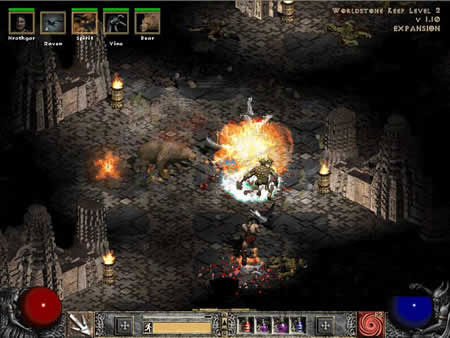 |
|
Exploding demons, berserker barbarians and enraged grizzlies. What more could you ask for from a game?
|
Though initially a Mac Classic application, Blizzard has done a good job in keeping the game fresh by releasing OS X versions of the application. Periodically they update the game by tweaking its many features, for example to make the various character classes more balanced in playability compared to one another. Sometimes this means reducing the powers of certain skills and abilities on one character class while strengthening them in others, at other times it’s about fixing bugs in skills that made them ridiculously powerful or uselessly weak. New recipes for crafted items are another popular addition to the game with each update. The latest update is version Diablo 2 v. 1.10, and though still beta Blizzard have provided a Mac OS X version of it that dramatically improves the performance of the game with certain graphics cards, among other benefits. It is because it is continually tweaked and improved, Diablo remains among the best game in its class, and a classic Mac game.
- Product: Diablo Battle Chest (includes Diablo, Diablo 2 and the Lord of Destruction expansion set)
- OS X: Yes (Diablo 2 and expansion set, requires download from the Blizzard website)
- Classic: Yes
- Publisher: Blizzard
- URL: http://www.blizzard.com/diablo2/
- Buy it at Amazon
- Category: Game
- Price: $40
- Requirements:
- Diablo: Power Macintosh running OS 7.5
- Diablo 2: Fast G3 or better running OS 8.1, ideally with an OpenGL, RAVE or Glide video card

Leave a Reply
You must be logged in to post a comment.